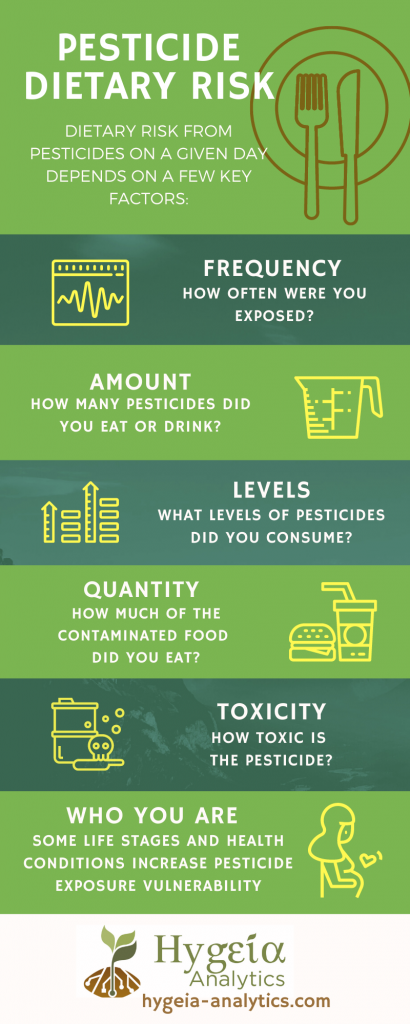 This graphic illustrates the six key factors that drive pesticide dietary exposure.
This graphic illustrates the six key factors that drive pesticide dietary exposure.
Historically, excessive dietary exposure and risk has been the predominant reason why the EPA has taken action to reduce the use of an already-registered pesticide. Likewise, the data required and depth of analysis conducted by EPA is far greater in the case of food use pesticides known to result in human exposures via residues in food.
Human Health Impacts
Even at low doses, pesticides can disrupt prenatal development and pose unique risks to infants, children, and adults with compromised immune systems or certain genetic polymorphisms (e.g., there is a genetic variant that reduces the body’s ability to metabolize organophosphate insecticides that increases risks 10- to 100-fold among certain individuals).
Common levels of exposure to certain organophosphate insecticides can reduce a child’s IQ by 4 to 7 points, a reduction comparable to that triggered by lead exposure levels common during most of the post-WWII period, until major steps were taken nation-wide to remove lead from gasoline and paint.
A growing body of evidence links prenatal and early-life pesticide exposures to heightened risk of autism, ADHD, asthma, food allergies, diabetes and obesity. The U.S. President’s Cancer Panel has suggested avoiding food grown with pesticides to decrease the risk of environmentally-induced cancers.
Developmental and cancer risks are especially worrisome for infants and growing children, because children eat more relative to their body weight than adults, and a child’s organs are less efficient in detoxifying pesticides than adults.
Exposure to pesticides is also a known-risk factor for women and men of reproductive age, because pesticides can undermine reproductive health and birth outcomes. For example, a joint report by the American College of Obstetricians and Gynecologists and the American Society for Reproductive Medicine reports that environmental chemicals such as pesticides can increase the risk of spontaneous abortions, certain birth defects, and undermine long-term neurological health.
Better understanding the impact of pesticide exposure in pregnancy on chidbirth and child development is the focus of The Heartland Study, and there is a wealth of information available in the bibliography on their webpage.
The Dietary Risk Index
Understanding the scope–and location–of a problem is a key step in solving it. There are over 600 pesticides applied routinely to hundreds of different food crops, under widely different circumstances across millions of farm fields. But which applications pose dietary risks worth worrying about and which do not?
Are pesticide risks going up or down? What about imported food – riskier or safer? Which foods pose the greatest risks, and which the least? To what extent does organic farming reduce pesticide dietary risks?
Our Pesticide Dietary Risk Index (DRI) is an analytical system that was designed to answer questions like these. The database gathers data on pesticide residues in foods and pesticide toxicity in order to quantify the relative risk from dietary exposure for a typical serving of a given food in a given year. Dive into the DRI here!
